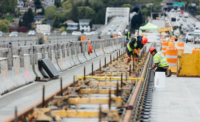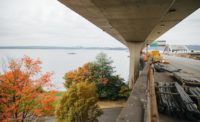Curved-Element Design Allows Rail on Floating Bridge

Curved elements will allow rail tracks to sit on a “three-legged stool” when crossing between fixed and floating elements of a bridge.
DIAGRAM COURTESY OF WSP

Curved elements atop bearings let light-rail track move with the bridge.
RENDERING COURTESY OF SOUND TRANSIT


Seattle’s Sound Transit had a challenging problem: how to get a new light-rail line on and off a nearly 1-mile-long Interstate 90 floating bridge while protecting the rails from the constant movement of the water. A solution to transition trains safely from fixed to floating structures has now been approved after three years and $53 million in rigorous design and testing.
One of the world’s longest floating bridges, the I-90 bridge connecting Seattle to points east across Lake Washington was earmarked for light-rail service by a voter-approved sales-tax measure in 2008.
It was an opportunity to find solutions “without just looking at how it was done before,” because a search found no precedents for engineering such a multimodal joint, says John Sleavin, Sound Transit executive technical adviser and lead engineer on the project. “You had to go back to engineering principles,” he says.
The issue was how to install rails on an accordion-joint bridge to transition from a fixed structure to a floating structure that fluctuates as much as 2 ft in elevation. Anchored to the lake bed, the bridge also moves slightly north and south in prevailing winds. “It moves up and down, and left and right,” Sleavin says. “Based on traffic loads and other things, the bridge [also] can rotate. In all, we have six directions of movement at a single joint, [but] we are only talking about a half-degree roll or angle change. Cars don’t really notice it, but if you put half a degree in a steel item, it will snap.”
Beginning in 2011 with a consulting team led by what is now WSP, Andy Foan, director of U.K.-based Andy Foan Ltd., devised the “Curved Element Supported Rail,” a winged, curved platform at the two joints where the bridge transitions between fixed and floating. The 43-ft-long platforms support the rail on what Sleavin describes as a three-legged stool and let 300-ton trains run at speed. Foan describes it as a continuously-variable-radius track panel that “spreads the track curvature at the transitions and maximizes the speed at which it’s comfortable and safe to ride across,” he says.
Each rail sits on its own plane. To keep them equidistant from each other, the team devised ties on the curved platform that sit atop double-pendulum bearings such as are used in seismic building systems, allowing motion under each tie while still keeping the rails together.
While team members knew how each item performed individually, they used computer modeling to see how they reacted together. Then, they modeled the system in the University of Washington’s structural lab.
Sound Transit created two full-size track bridges and tested them at Transportation Technology Center Inc., Pueblo, Colo., using ballast to jack the bridge into different positions and tracing 500 channels of data along the way. “It correlated very well with what we were seeing,” Sleavin says. “We found a few things that allowed us to tweak and add camber in different places.”
With weight and balance key considerations on the Washington Dept. of Transportation-owned a floating structure, engineers will replace some ballast in the pontoons and add post-tensioning.
The East Link addition calls for 14 miles of new track on a $3.7-billion project, including $712 million for the two stations and track across the floating bridge. Sound Transit hired the joint venture Kiewit Hoffman to construct this section. Sleavin expects crews to start adding rail in summer 2018. Revenue service is slated for 2023.
Future plans call for the state Route 520 bridge—the world’s longest floating bridge, also located on Lake Washington—to receive light rail, too. Sleavin says that plan becomes possible with this new solution.








